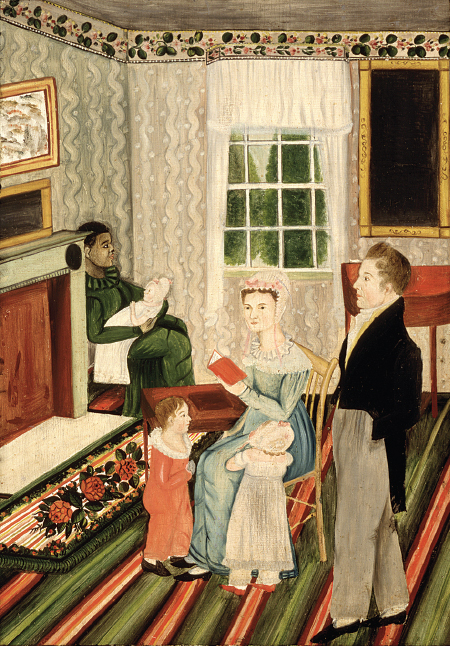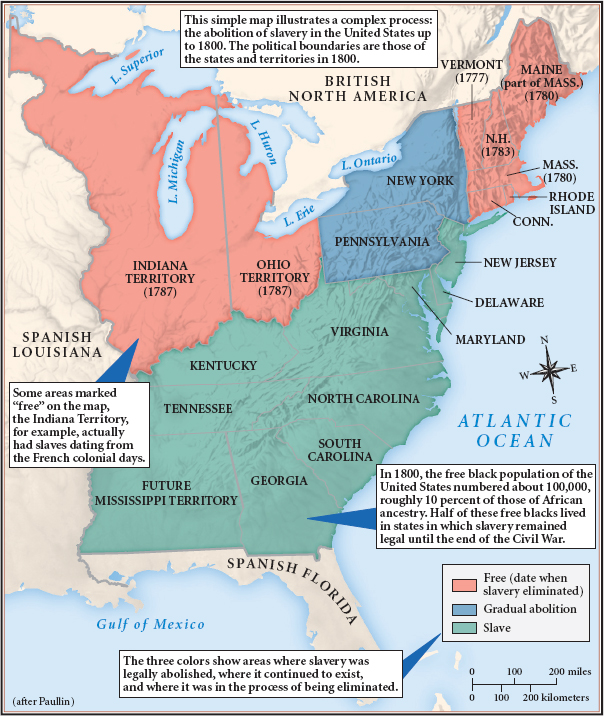America’s History: Printed Page 264
America: A Concise History: Printed Page 237
America’s History: Value Edition: Printed Page 230
The Revolution and Slavery, 1776–1800

In fact, the whites’ struggle for independence had raised the prospect of freedom for blacks. As the Revolutionary War began, a black preacher in Georgia told his fellow slaves that King George III “came up with the Book [the Bible], and was about to alter the World, and set the Negroes free.” Similar rumors, probably prompted by Royal Governor Lord Dunmore’s proclamation of 1775, circulated among slaves in Virginia and the Carolinas, prompting thousands of African Americans to flee behind British lines. Two neighbors of Virginia Patriot Richard Henry Lee lost “every slave they had in the world,” as did many other planters. In 1781, when the British army evacuated Charleston, more than 6,000 former slaves went with them; another 4,000 left from Savannah. All told, 30,000 blacks may have fled their owners. Hundreds of freed black Loyalists settled permanently in Canada. More than 1,000 others, poorly treated in British Nova Scotia, sought a better life in Sierra Leone, West Africa, a settlement founded by English antislavery organizations.
Manumission and Gradual Emancipation Yet thousands of African Americans supported the Patriot cause. Eager to raise their social status, free blacks in New England volunteered for military service in the First Rhode Island Company and the Massachusetts “Bucks.” In Maryland, some slaves took up arms for the rebels in return for the promise of freedom. Enslaved Virginians struck informal bargains with their Patriot owners, trading loyalty in wartime for the hope of liberty. Following the Virginia legislature’s passage of a manumission act in 1782, allowing owners to free their slaves, 10,000 slaves won their freedom.
Two other developments — one religious, the other intellectual — encouraged manumission. Beginning in the 1750s, Quaker evangelist John Woolman urged Friends to free their slaves, and many did so. Rapidly growing evangelical churches, especially Methodists and Baptists, initially advocated slave emancipation; in 1784, a conference of Virginia Methodists declared that slavery was “contrary to the Golden Law of God on which hang all the Law and Prophets.”

Meanwhile, Enlightenment philosophy challenged the widespread belief among whites that Africans were inherently inferior to Europeans. According to John Locke, ideas were not innate but stemmed from a person’s experiences in the world. Pointing out the obvious — “A state of slavery has a mighty tendency to shrink and contract the minds of men” — Enlightenment-influenced Americans suggested that the debased condition of blacks reflected their oppressive captivity. Quaker philanthropist Anthony Benezet declared that African Americans were “as capable of improvement as White People” and funded a Philadelphia school for their education.
Swept along by these religious and intellectual currents, legislators in northern states enacted gradual emancipation statutes (Map 8.2). These laws recognized white property rights by requiring slaves to buy their freedom by years — even decades — of additional labor. For example, the New York Emancipation Act of 1799 allowed slavery to continue until 1828 and freed slave children only at the age of twenty-five. Consequently, as late as 1810, almost 30,000 blacks in the northern states — nearly one-fourth of the African Americans living there — were still enslaved. Freed blacks faced severe prejudice from whites who feared job competition and racial melding. When Massachusetts judges abolished slavery through case law in 1784, the legislature reenacted an old statute that prohibited whites from marrying blacks, mulattos, or Indians. For African Americans in the North, freedom meant second-class citizenship.
Slavery Defended The southern states faced the most glaring contradiction between liberty and property rights, because enslaved blacks represented a huge financial investment. Some Chesapeake tobacco planters, moved by evangelical religion or an oversupply of workers, manumitted their slaves or allowed them to buy their freedom by working as artisans or laborers. Such measures gradually brought freedom to one-third of the African Americans in Maryland.
Farther south, slavery remained ascendant. Fearing total emancipation, hundreds of slave owners petitioned the Virginia legislature to repeal the manumission act. Heeding this demand to protect “the most valuable and indispensible Article of our Property, our Slaves,” legislators forbade further manumissions in 1792. Following the lead of Thomas Jefferson, who owned more than a hundred slaves, political leaders now argued that slavery was a “necessary evil” required to maintain white supremacy and the luxurious planter lifestyle. In North Carolina, legislators condemned private Quaker manumissions as “highly criminal and reprehensible.” Moreover, the slave-hungry rice-growing states of South Carolina and Georgia reopened the Atlantic slave trade. Between 1790 and 1808, merchants in Charleston and Savannah imported about 115,000 Africans, selling thousands to French and American sugar planters in Louisiana.
Debate in the South over emancipation ended in 1800, when Virginia authorities thwarted an uprising planned by Gabriel Prosser, an enslaved artisan, and hanged him and thirty of his followers. “Liberty and equality have brought the evil upon us,” a letter to the Virginia Herald proclaimed, denouncing such doctrines as “dangerous and extremely wicked.” To preserve their privileged social position, southern leaders redefined republicanism. They restricted individual liberty and legal equality to whites, creating what historians call a herrenvolk (“master race”) republic.
IDENTIFY CAUSES
Question
Why did aristocratic republicanism develop in the South, and what were its defining features?